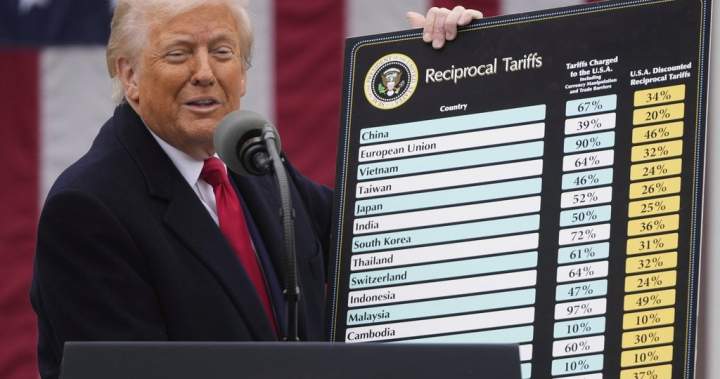The end of duty-free shipping — also known as the de minimis exemption — to the United States is set to begin on Aug. 29 and for many Canadian businesses already at risk of shutting down due to tariffs, that could mean more financial pain.

On Friday, an executive order signed in July by U.S. President Donald Trump will take effect, removing de minimis exemptions that have been in place for decades.
This will increase costs and lead to additional hurdles for Canadian businesses if they want to ship goods across the border to U.S. customers.
Those goods entering the U.S., according to the White House, will face “all applicable duties” as of Aug. 29, whereas for decades they’ve been allowed to enter duty-free if the value is under US$800.
Story continues below advertisement
“As an e-commerce business in Canada, the de minimis exemption is everything. It’s absolutely everything. I’m fearful for everybody’s businesses now that it’s being removed,” Hockey Stick Man owner and founder Joey Walsh says.
“It’s going to require a formal entry for goods entering into the United States and tariffs will be charged. The tariffs are almost secondary to the paperwork and the logistics and everything else, and the associated costs of having a company broker the product into the U.S.”

5:46
End of ‘de minimis’ rule brings new costs for small businesses
What is the de minimis exemption and how is it changing?
The de minimis exemption has allowed businesses that send lower dollar value shipments to customers to expand their market share in the U.S. relatively easily.
Story continues below advertisement
That also means less paperwork and less of a burden on small businesses.

Get breaking National news
For news impacting Canada and around the world, sign up for breaking news alerts delivered directly to you when they happen.
“You don’t need a formal U.S. customs declaration. You don’t have to provide all kinds of data in advance. And those shipments can enter the U.S. market tariff- or duty-free. That’s no longer going to apply as of Aug. 29,” says John Boscarial, international trade and investment lawyer and a partner at McCarthy-Tétrault.
“Now, for a lot of businesses, some large businesses, but for many small and medium-sized businesses in Canada that have relied on this exemption, things are going to change in a very big way going forward.“
More on Lifestyle
More videos
With the exemptions removed, Canadian businesses could see a sharp drop in U.S. customers who don’t want to face the risk of additional fees or the burden of extra paperwork to receive their items.
While some items may be exempt from these extra fees if the business can prove the items fall under the terms of the current Canada-United States-Mexico Agreement (CUSMA), this can mean a lot of extra effort and may not always work.
“That can unfortunately be a complex process, depending on what that product is. Businesses will have to do a bit of work to figure out what their tariff classification (is) under CUSMA,” Boscariol says.
“Even if you meet those CUSMA requirements, there’s still going to be some things you have to do going forward to ensure that you qualify and can demonstrate or prove to U.S. customs that you qualified.”
Story continues below advertisement
The U.S. rule change applies to all countries, not just Canada.
And where with some products, the end of duty-free shipping may mean paying certain fees, in other cases, products could be subject to the actual tariff rates applicable to each country.
For Canada, the tariff rate imposed by the United States is currently 35 per cent for non-CUSMA items.
“In the short term, businesses are going to face big challenges in dealing with this 35 per cent tariff. Currently, the Canadian government is in negotiations with the United States on how to deal with these issues,” Boscariol say.
Trending Now

Canada Post lost $407 million in ‘largest loss’ in a single quarter

Trump dump? More than half of Canadians with U.S. properties want to ditch them
“De minimis has not been, at least publicly, raised as part of those negotiations, but I would expect that if the Canadian government can come to some resolution over that 35 per cent tariff, and perhaps get that lowered or eliminated, perhaps there could be a reinstatement of the de minimis exemption for Canada, given the close nature of our trading and economic relationship with the United States.”
In the meantime, business owners may be faced with hard times.

2:07
Business Matters: End of key loophole is as devastating to some Canadian businesses as Trump’s tariff threat
The trade war sparked by Trump’s tariff policies has led to concerns among business owners and consumers alike on both sides of the border, including the “uncertainty” of how the trade war will evolve.
Story continues below advertisement
“We know that one in three Canadian small/medium enterprises will be impacted with this change…. What this will mean is that it could increase their costs, make their product less competitive or less appealing to the U.S. market,” says senior policy analyst Michelle Auger at the Canadian Federation of Independent Business.
“For some of those businesses, it’s going to be a hit to their bottom line, unfortunately, and that can have rippling effects throughout the Canadian economy.”
Some small business owners in Canada have already been feeling the effects of the trade war as tariffs sour consumer sentiments on both sides of the border, and current tariff measures already weigh on businesses.
A separate survey conducted by the CFIB found that one in five small business owners in Canada said tariffs may force them to close within the next six months.
“About 40 per cent of my online business is going to the U.S., and this has created a lot of uncertainty and definitely a drop in my U.S. business,” says owner Kim Doherty at Fleece and Harmony, a small woollen mill in Prince Edward Island.
“My U.S. orders have probably declined by about 25 per cent since the whole tariff talk has started because quite frankly, a lot of people don’t understand what’s going to happen or they anticipate that the rules might be reversed again.”
Story continues below advertisement
The near-term risk for some customers, from both the current tariff measures in place and the removal of the de minimis exemptions on Friday, means businesses will have to raise prices to maintain margins.
“However the cost is absorbed, however businesses continue to try to make their products more attractive, we will start to see the increase on the consumer’s end. Because somewhere we need to recover that cost from a small business perspective,” Auger says.
© 2025 Global News, a division of Corus Entertainment Inc.

